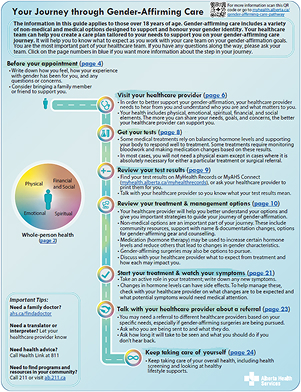Preferred name
Your healthcare provider should ask for your preferred name so that they can address you properly. But they may also ask you for the name that is on your medical chart or legal documents. An example of how to respond could be: “The name I go by is _______. There is a different name that I do not go by on my medical records, which is _______.”
Privacy
You may not want to talk about the reason for your visit or the name or pronouns you use in a waiting room. To respect your privacy, you can ask for a private space to discuss your needs or ask to confirm certain information by writing it down on a piece of paper rather than speaking it out loud in front of others.
Talking with your healthcare provider
When you see your healthcare provider, they will review your history. They may ask questions to better understand what you are experiencing, thinking, or feeling in relation to your gender identity. Physical exams are often not necessary for most gender-affirming primary care.
Your healthcare provider will be trying to better understand your situation to gather the information they need to support your gender-affirming goals. You are the most important part of your healthcare team. The more you can share your needs, goals, and concerns, the better your healthcare provider can support you.
Things to share with your healthcare provider include:
- Your experience with gender identity and how this may differ from your sex assigned at birth.
- How your experience with gender identity impacts your daily life, your work, your relationships, and other things that are important to you.
- Any strong desires to express yourself or be perceived as a gender different than the one you were assigned at birth. This might also include talking about your appearance.
- Things that can impact your ability to manage your health, like problems with money, housing, and transportation, experiences from your childhood, or alcohol and drug use.
Sharing these things and voicing these feelings can be difficult. Sometimes writing things down and trusting that your healthcare provider wants to help can make sharing this a bit easier.
Making the most of your appointment
If you don’t understand what your healthcare team is telling you, let them know right away. Be open and honest. You might say:
- “It sounded like you said that I should… Did I understand that correctly?”
- “Can you show me a picture or model to help me understand?”
- “Do you have a written resource where I can read more about it?”
You may need to talk about relevant language to make sure you and your healthcare provider are using common terms in the same way. The LGBTQIA+ glossary of terms for healthcare teams can help with this.
Learn more about working with your healthcare team and making the most of your appointment.

Gender-Affirming Care Pathway for Adults
Download or print the
full patient pathway (PDF) and
summary (one-page PDF) to learn more about your journey through gender-affirming care.
Patient Pathway  Summary
Summary 
